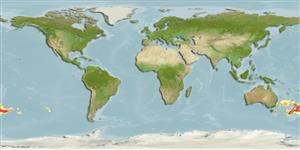Pycnogonida |
Pantopoda |
Pycnogonidae
Environment: milieu / climate zone / depth range / distribution range
Ecology
Benthic. Subtropical
Southwest Peninsula: New Zealand.
Length at first maturity / Size / Weight / Age
Maturity: Lm ? range ? - ? cm
Trunk ovoid with very short lateral processes. Trunk with three low dorsomedian bulges. Proboscis a plain, slightly inflated cylinder tapering distally to small mouth area. Abdomen short, laterally inflated. Ovigers entirely lacking in both sexes. Legs very robust, coxae shorter than their diameters, femur with proximoventral bulge and dorsodistal knob and bulge. Second tibia only slightly longer than the width. Tarsus triangular, with few sole spines. Propodus well-curved, wider at base than distally, with only distal sole spines, claw very robust, about 0.6 of propodal length. Without auxiliary claws. It cannot be predicted with any certainty whether or not this species has male ovigers, but if not, it joins the other species in this genus which have auxiliary claws, however small, and these must serve to separate these two otherwise similar members of the New Zealand fauna (Ref. 9).
Depth estimate based on Family (Ref. 9).
Life cycle and mating behavior
Maturity | Reproduction | Spawning | Eggs | Fecundity | Larvae
Members of the class Pycnogonida are gonochoric and sexually dimorphic. During copulation, male usually suspends itself beneath the female. Fertilization occurs as the eggs leave the female's ovigers. Males brood the egg masses until they hatch. Life cycle: Eggs hatch into protonymphon larva then to adults.
Child, C.A. 1998. (Ref. 9)
IUCN Red List Status (Ref. 130435)
CITES status (Ref. 108899)
Not Evaluated
Not Evaluated
Threat to humans
Human uses
| FishSource |
Tools
More information
Age/SizeGrowthLength-weightLength-lengthMorphologyLarvaeAbundance
Internet sources
Estimates based on models
Price category
Unknown.
